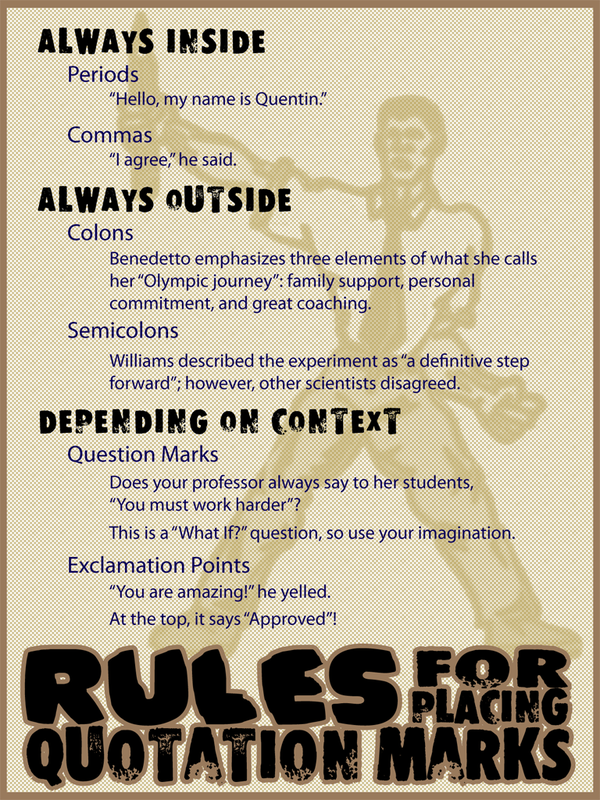When To Use a Quotation:
Quotations should be impactful. They should not be used to provide basic factual information; therefore, the majority of your research should be summarized or paraphrased. You should only use quotations if you want to accomplish one of the following goals:
- You want to use an expert's exact words to support your argument
- You want to disagree directly with an author’s argument
- You want to incorporate a particularly meaningful or powerful phrase or passage into your own writing without plagiarizing
- You want to compare and contrast specific points of view
- You want to acknowledge important research that pre-dates your own
- You want to show the character of the person you are writing about
- Let a person speak in their own words about an issue that is important to them
- Quote a passage from a work of fiction that you will be analyzing closely
Basic Tips for Incorporating Quoted Material:
- Readers should be able to move from your own words to the quotation without feeling a jolt.
- Use signal phrases to prepare your readers for the quotation.
- Make sure your signal phrase helps your reader understand the purpose of your quotation and see its connection to the rest of your writing.
- Vary your signal phrases. For example:
Jacobsen responds to his critics by saying: “. . .”
Canada is a country of “. . .”
“. . .,” explained Prime Minister Trudeau.
“. . .,” writes Mordecai Richler, “. . .”
- When your signal phrase includes a verb, try to avoid always using the word "said." Choose one that is appropriate for the context. Is your source arguing a point, making an observation, reporting a fact?
Words you might use: admits, agrees, argues, asserts, believes, claims, compares, concludes, confirms, contends,
declares, denies, describes, emphasizes, explains, insists, notes, observes, points out, reasons, refutes, rejects,
reports, responds, suggests, thinks, writes
- It is not always necessary to quote full sentences from a source. You can also incorporate a phrase into your own sentence.
Using Brackets:
- Brackets are square parentheses: [ ]
- Use brackets when you want to insert words into a quotation that are not part of the original material. This technique is especially useful if you want to clarify or explain some information provided in the quotation:
“He [William Shakespeare] was not for an age, but for all time.”
- Brackets can be used to indicate that you have changed one or two words within a quotation.
For example, you are quoting an interview with a celebrity who is discussing his latest film. When discussing his role he says, “It really took a lot out of me.”
When using the quote in your article, you decide to change it for clarification so it reads: “[The role] really took a lot out of me.”
- Brackets may also be used to keep a quotation grammatical within the context of the surrounding sentence.
For example, the passage to be quoted reads: “Her novel was one of the first examples of Canadian Gothic fiction.”
You plan to incorporate it into a sentence that is written in the present tense, so you use brackets to change the tense of the verb: After reading the novel, it is easy to understand Woodrow’s claim that it “[is] one of the first examples of Canadian Gothic fiction.”
- Never use brackets to alter the meaning of the quotation.
Using Ellipsis:
- Ellipsis is three periods with a space between each one: . . .
- Use ellipsis whenever you omit words.
For example, the original statement reads “History is, and remains, an ongoing dialogue between the past and the present.”
You decide you don’t want to use the whole quote in your essay, so you use ellipsis to omit the words you don’t want to use: “History is . . . an ongoing dialogue between past and present.”
- When you want to omit a full sentence or more, use a period before the three ellipsis dots (4 dots total).
- Do not use ellipsis at the beginning or end of a quotation.
- Do not use ellipsis to alter the meaning of a quotation.
Punctuating Quotations:
If the signal phrase is a complete sentence, use a colon. The Mountie is one of the most iconic Canadian symbols: “Pierre Berton estimates that about half the movies made in Hollywood about Canada featured Mounted Police” (Francis 31). If the signal phrase is not a complete sentence, use a comma. According to Canadian historian Daniel Francis, “The myth of the CPR . . . is that the railway made Canada” (Francis 26). If you have incorporated the quotation into your own thoughts or ideas, you need to use quotation marks, but no other punctuation is necessary. In every beer commercial it is possible to see that “our link to the land is a defining national characteristic” that inspires patriotism from sea to sea (Francis 149). |

